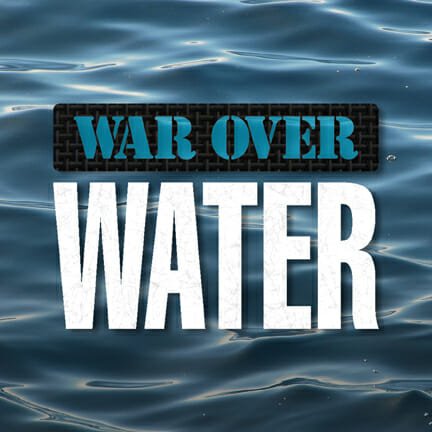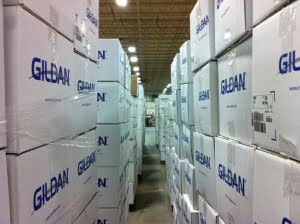It is probably fitting that the term for the sign of a weakness is called an “Achilles Heel” as it matches up wonderfully with an upcoming, unspoken battle facing the decorated apparel industry.
The war over water.
If you remember your Greek mythology, Achilles was dipped into the river Styx as an infant by his mother Thetis to give him divine protection in battle. Because she held him by his heel, that was the only part of his body was that wasn’t protected. Achilles, despite his Brad Pitt good looks, later died when struck by an arrow in his heel during battle.
For apparel decorators, we’re in the same predicament. Except, nobody is really talking about our weakness, which like Achilles, is associated with water. We don’t look like Brad Pitt either.
For most shops, nobody stops to think about how much water plays into your business as we’re already overburdened with orders that have to ship, customer service challenges, employee training and motivation, continuous improvement programs, and a myriad of other things that call for more immediate attention than one sustainability issue. There just isn’t any top of mind for this.
So why the alarm anyway?
First, let’s take a look at some points to consider. In America, and also all over the world, we’re seeing huge emphasis placed on restricting the amount of water that can be used every day. This can be from a weather related condition, over-usage in the community, or other factors.
Our cities have crumbling infrastructure with water pipes that have been buried underneath the ground for so long, the amount of leaks in them is virtually uncountable. Think about the rate changes and increased fees that have impacted users in Austin, Las Vegas or Atlanta. Not to mention the elephant in the room in Flint Michigan. If you live in southern California, I’ll bet you or your state governmental leaders have an opinion too. Check out this amazing article about the $1.3 billion pipe replacement problem in Los Angeles. There is even an interactive map that shows where the leaks are in the neighborhoods!
In industrialized nations, freshwater use by industry accounts for about half of the consumption. How industry uses water is important, as this has a direct effect on the amount of water available for everyone else. In areas with large agriculture or manufacturing, water can be allocated to these commercial endeavors rather than to people. That’s the choice that is being made. Every day.
Have you been affected by water restrictions?
In developing nations, as industry continues to grow, more water will be allocated to support the endeavors, but will there be balance with the water support needed for its population? Water security is a big deal. How governments handle water for businesses can have a major impact on your company and there’s not a lot you can do about it. Not all of your cotton comes from domestic sources. Mining for the minerals that are used as the basis for pigments can use water too. What happens to our supply chain when a country chooses to divert water for industry to water for their people?
Which is more important?
There isn’t enough water to go around sometimes. We have a supply and demand economy. The cost of water is going to skyrocket soon, if it hasn’t already in your area. For some, the cost of water is expected to outpace the cost of inflation.
To make this even more difficult, one of the biggest factors in the challenge is the increased cost of treating wastewater, so we can reintroduce the water back into circulation for use. The wastewater from industry is constantly being loaded with pollutants such as heavy metals, nutrients, pathogens, and also organic and inorganic materials. Couple that with all of the material that is sent down the drain from household use and also stormwater runoff, and it’s a complex problem to sort out.
There is an enormous cost to filter all of that out and get the water back to a more natural, usable condition. As this cost continues to rise, so will the cost of available water.
Water in Our Industry
Let’s look at what we use for our go-to platform for decoration. The cotton t-shirt. Here’s a term I want you to learn today, and that is “Virtual Water”. This is the amount of water needed to produce something, even if the final product doesn’t resemble water in any way.
For a t-shirt it takes 713 gallons (2,700 liters) of water to grow enough cotton to make a single t-shirt. How many cotton shirts do you decorate a day? Multiply that by 713. That’s how much water was used just to grow that cotton for your daily production output.
That’s a big number. For comparison, it takes about 2,500,000 gallons of water to fill an Olympic size swimming pool. For fun, calculate how many shirts you decorate a year versus how many swimming pools you could fill with that water. Go ahead, I’ll wait.
Don’t forget it still takes more water to dye the shirt or apply rinses, and water is used to cool the power plants that make our energy. In our shops, water is used for reclaiming and rinsing screens after exposure. Let’s not forget that whether that shirt was printed or embroidered, up to forty gallons of water is used each time someone does the laundry.
Water is directly linked to our industry. From cradle to grave, and in multiple aspects.
Shouldn’t we then be more responsible for how we use water? Where is the discussion? I just don’t see it. Some companies though sell equipment or are offering products that directly align with this water issue. Do you use them?
For example, M&R has a screen washout booth called the Eco-Rinse that recirculates the water in a tank, rather than using new water for each screen for rinsing like you might with a water power washer. Kiwo has been marketing the Grunig G-Wash 133 Screen-Reclaim System with a water filtration tank that has a series of filters to remove debris and solids before they go down the drain. Rhinotech has a good quality filtration system and pump, the M10, that you can add to your washout booth too. Franmar has long since marketed its drain-safe screen cleaners, and recently changed the name of their line. These are but a few of the products in our industry that you could be using. Have you considered them or others? Does our supply chain offer good leadership on this topic?
On the apparel blank front, cotton growers all over the world have been experimenting with crops that use less water, and are seeing good results. There are organizations like The Better Cotton Initiative (BCI) that are promoting improved agricultural methods worldwide. The goal is to grow cotton that uses less water and pesticides, while producing better yielding crops. For our industry’s sake, let’s hope positive progress continues to be made.
Both Nike and adidas have developed methods of dying garments that use super-heated CO2 instead of water. This minimizes the impact that water has on the manufacturing of the shirt, and also uses less energy as well. A long list of textile manufacturers has even adopted a new global strategy to minimize the impact of wastewater discharge called the Zero Discharge of Hazardous Chemicals. The stated goal of the ZDHC is to have the apparel and footwear industry’s supply chain have zero discharge of hazardous chemicals by 2020. Love this. Who else has signed up?
Are the garment manufacturers in our industry keeping abreast with this issue too? Ask your clothing line rep the next time they stop and unload their virtual showroom for your shop. How is water used with their apparel line manufacturing? Are they members of ZDHC? Could our industry adopt a better strategy with some sourcing labeling or tracking? Unfortunately, if past history is any indication, unless the folks that buy the products ask for change it may be slow coming.
But what does all this mean to your average apparel decorator? Here are some thoughts and tips:
- Anticipate that your water bill is going to continue to climb. This includes your wastewater and sewer if you are billed separately with a fee. In some areas you may see added fees based on water consumption. Utility companies are struggling with keeping up with the infrastructure changes needed. Consumers will be paying for these improvements. That means you.
- Your shop could see more frequent inspections or audits. If you service bigger brands and do social and safety compliance audits, water use may be on the list of things the auditor inquires about. Be prepared. In your area, companies that send contaminants down the drain could be targeted. It’s easier to treat the wastewater if there are less contaminants involved, so there could be more policing on that front. Know your products that you are using by reviewing the SDS sheets, and try to find safer and less toxic consumables. If you don’t have one already, consider getting a filtration system for your reclaim area. You can also have your shop’s drain effluent privately tested. You can Google firms in your area that do this. It’s good to have the documentation available, and it’s relatively not that expensive to do compared to the cost of an OSHA or other governmental agency fine.
- Remember, waterbased inks are not necessarily drain safe. Make sure you handle any consumables as directed by the SDS sheets, and your local and state regulations. Your drain is not for dumping. Dispose of materials properly. Make sure you train your staff that handles materials before they do anything stupid.
- As the war with water continues, plant based apparel that uses water could be affected, especially if there are significant drought occurrences with crops. Recycled content and synthetic fibers will continue to be added to stretch out the composition of garments. This means you’ll be decorating more cotton blends or 100% polyester. If you haven’t mastered decorating on this type of apparel, you’ll need to increase your knowledge.
- More companies will continue to place emphasis on how their materials are grown or sourced. From companies like Patagonia and Levi’s to smaller firms like Cotton of the Carolinas, where consumers can track where the cotton for their shirt is sourced, this is a newer trend that has legs. Like restaurants promoting farm to table, retailers may be soon marketing the origins of the materials of the products, and how they were grown. How could you do something like this to become a market differentiator in your area? It pays to be a winner.
- Depending on where your shop is located, you could see water use restrictions or governance at times. Investing in recirculating systems for washing your screens out could make a logical choice for smoother and a more cost effective operation. Filtration systems in some areas are already mandatory, and this trend will just continue as cities or states pass legislation or regulations requiring them.
- The impact to this issue with your business may seem miniscule; however if everyone sees this as a no-win scenario nothing will ever improve. Do your part by looking at the chemicals you use, how you use water in your facility in your process, even how you landscape and treat the plants around your building. The US Environmental Protection Agency has a great program called WaterSense that may help you sort out any questions or challenges you may have with your shop.
- Embroiderers aren’t off the hook either. How many cotton sportshirts, jackets or hoodies are you branding a year? What happens to your sales when there is a spike in the cost of cotton due to water issues or drought? Find and offer alternative garment choices and be prepared.
- If you are concerned about how your shop handles compliance issues and want to be sure you are doing all you can, SGIA has a great compliance tool for members called the SGIA Environmental Self Audit that you can take to ensure you are up to current standards. Click Here for more information.
- Don’t think you can make a difference or things like this don’t matter? Big brands and other buyers will be looking for companies that handle sustainability issues as part of their everyday business plan. Growing your sales by leveraging your sustainability initiatives is smart business. You can make a difference by becoming a Sustainable Green Printing Partnership certified printer or patron. Click here for more information.
“Water and air, the two essential fluids on which all life depends have become global garbage cans.” – Jacques Yves Cousteau
“Water is the driving force of all nature.” – Leonardo da Vinci
“You don’t drown by falling into water. You only drown if you stay there.” – Zig Ziglar





2 comments
lashiver@charter.net
Another great commentary worth the time to read. Keep it up. Lee
—————————————–
atkinsontshirt
Thanks Lee!